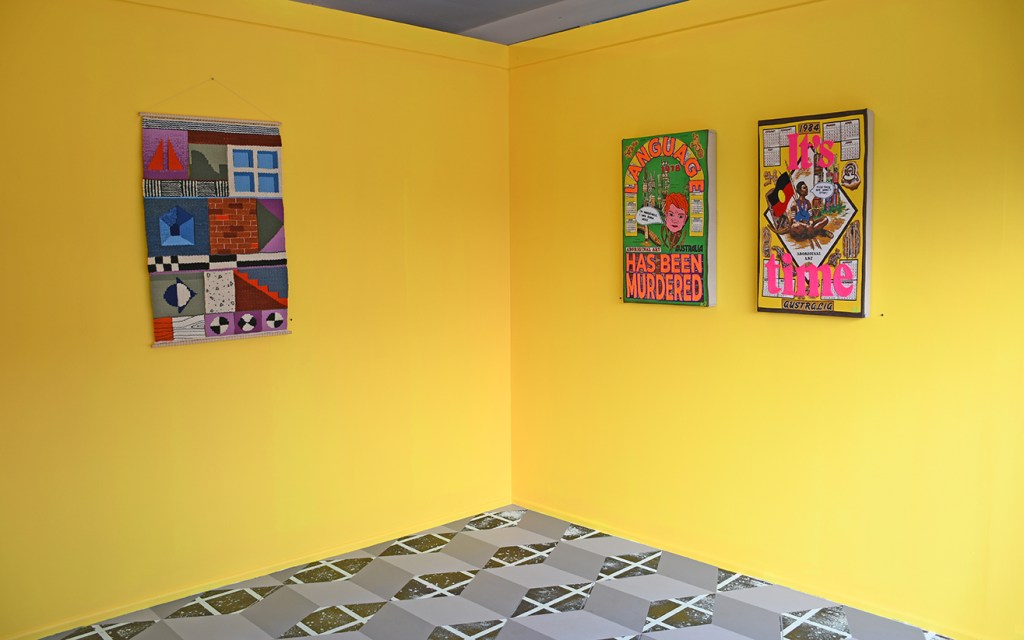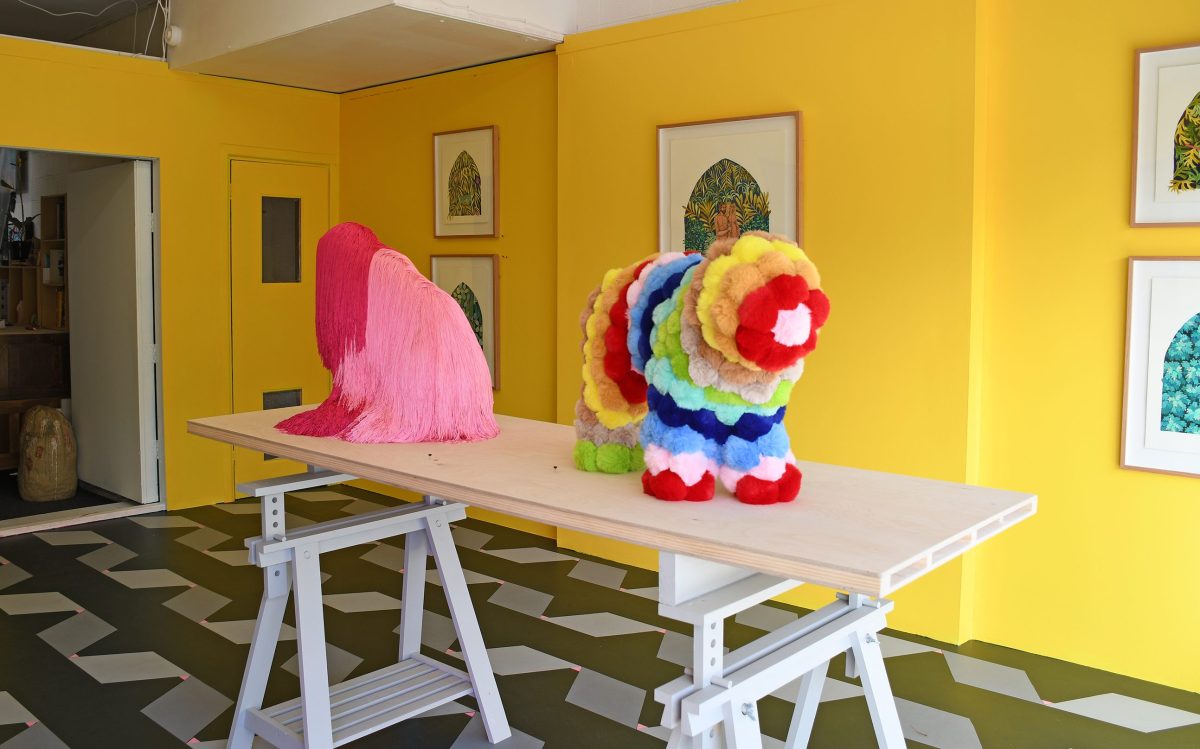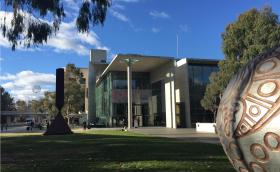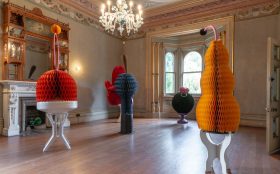Like many of the Haus of Vovo’s exhibitions, the latest show, Holding Pattern, is colourful and eye-catching from the street – a signature of the gallery’s director and exhibition curator, Tricky Walsh.
Opening in January 2021 as a new addition to Tasmania’s cultural scene, Haus of Vovo is one of two new galleries in the small town of New Norfolk, half an hour’s drive north of Hobart. While the artworks in themselves are highly textured and colourful, it’s the striking yellow walls and painted gallery floors that pull the show together. The floors feature geometric patterning that gives the strange illusion of depth.
During this reviewer’s visit, a little girl pulled an adult to a stop outside the gallery, pointing at Troy Emery’s fantastical Spectral Kitten (2023), made up of clusters of colourful polyester pom-poms, and his slickly long-haired Pink Bellied Albino Quoll (2023). The girl’s eyes tracked to the tessellated floor and then the luminescent glass door. In this country town, Haus of Vovo stands out as a windowfront impossible to ignore.
The exhibition’s title is suggestive of something stuck in time, and yet there’s nothing staid about the mostly textile and fibre-work artworks that make up this show. From Elijah Money’s explicit fabric print, to Genevieve Griffiths’ architecture-inspired weavings, Jazz Money’s poetic text on basket-making and Kait James’ political embroideries, the works in Holding Pattern celebrate the sensuality and physicality of textiles while rejecting conservative associations.
James’ Tick Tock, We Won’t Stop (2023) repurposes Aboriginalia. The Wadawurrung artist has embroidered a 1984 “Aboriginal Art” tea towel decorated with Aboriginal art and motifs, obscuring the calendar print with a bold pink “It’s time” and adding fluorescent thread to the otherwise conservatively-toned memorial poles. James’ other work, Language Has Been Murdered (2021), features a pink-faced Senator Pauline Hanson embroidered over a similar “Aboriginal Art” calendar tea towel from 1978. A cartoon-like speech bubble include’s the senator’s famous divisive words “I’m Indigenous, I was born here”.
James’ additions enhance the kitschness of these once souvenir items, playing up the association between textiles and storytelling. They also draw attention to the damning disconnection between the somewhat romanticised motifs and depictions of Aboriginal culture, and the way in which Aboriginal people are treated.

Nicole O’Loughlin’s series of embroidered watercolours also combines contemporary symbols with more traditional motifs. Over decoratively painted foliage in the shape of lancet windows, O’Loughlin has delicately embroidered pieces of garbage. The brand names are immediately recognisable to a Tasmanian audience: McDonald’s fries spill from their red paper container into a mosaic of leaves, a Chiko Roll paper is snagged on a gumtree, and a Boag’s Draught can rests lightly on some pale leaves. An accompanying embroidery, Expulsion from the Garden (2021), depicts a naked couple, eyes-down as they shamefully walk through foliage, a soft drink container in hand. At odds with the ugliness of littering, the works are strikingly beautiful.
The tactile nature of fabric means that the temptation to touch textile artworks is always present. O’Loughlin’s embroidered doormat featuring the face of former Prime Minister, Scott Morrison, plays on the tension between the unwritten gallery rule of not touching the art, while highlighting the ubiquitous role of textiles in our everyday life. To enter the gallery, all visitors are forced to step on this hand-embroidered work, undermining authority in more ways than one.
It’s rare to see multigenerational family collaborations in contemporary art galleries, but given the familial tradition of handing down craft knowledge from generation to generation, it seems only appropriate that an exhibition celebrating fibre-work includes multiple mother-daughter collaborations. Jess Johnson and Cynthia Johnson’s Softmax (2023) quilt with its futuristic print is hung from a bar held by fierce pink claws, their sharpness at odds with the softness of the quilt.
Credited as Las Hermanas Iglesias (translated as “the sisters Iglesias”) and Bodhild Iglesias, the collaboration between sisters Janelle and Lisa, and their mother Bodhild, likewise draws attention to the effect of hanging textiles. Pinned to the wall, the knitted acrylic and wool blankets hang limply in the centre, billowing out in response to the stretch of surrounding fibres. It’s unclear as to whether the accompanying paintings, which echo the map-like patterning of the blankets, are the inspiration for or response to the knitted versions. The title, Mirror Mirror (2023), suggests this puzzle is deliberate.
Read: Exhibition review: Dean Cross, Canberra Contemporary Art Space
The works in Holding Pattern celebrate texture and pattern, exploiting the cultural connotations of textile work knowingly and strategically. There’s an undercurrent of humour that threads through the exhibition, with many of the works unapologetically kitsch, and others proudly subversive. The resulting show is original and entertaining, and well worth the trip to New Norfolk.
Holding Pattern is on view at Haus of Vovo, New Norfolk, Tasmania from 19 August to 17 September; free.
This review is published under the Amplify Collective, an initiative supported by The Walkley Foundation and made possible through funding from the Meta Australian News Fund.






